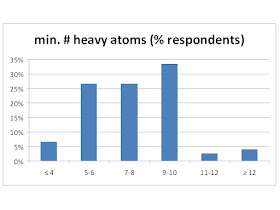The results of our most recent poll are in - here are the smallest fragments readers would allow in their library:
It looks like the smallest fragment most people would
include in their library has a median of 7 or 8 non-hydrogen atoms, just
slightly smaller than azaindole. More than 85% of respondents set a minimum
size of 5 to 10 heavy atoms, so if we take the Pfizer rule of thumb that each
heavy atom averages 13.3 Da, we’re talking 67 to 133 Da for the smallest
fragments.
These sound like reasonable limits; slightly smaller
molecules start becoming too volatile to handle reliably. Also, as Teddy pointed out, you’ll probably need either very sensitive methods to detect the
smallest fragments, or very impressive ligand efficiencies.
Our poll last year asked about the largest fragments, so
together these polls set a range of 5 to 20 heavy atoms for typical fragment
libraries.
Thanks to the 75 of you who voted in this most recent poll.
Thanks to the 75 of you who voted in this most recent poll.

So phthalic acid, heavy atom count 12, is not a viable fragment? Stop the presses, tell Zenobia to reconfigure their plates. Seriously, the simplest monosubstituted benzoate is going to be 10 atoms, and a nitrile... And since when have experienced early H2L guys been univariate in their perceptions (as if atom count was THE parameter that mattered). In my book (in preparation, TYVM), the matter is one of pharmacophores and not atoms, or molecular weight. E.g., I would love to see a designed library that included a stray tetrazole and sulfonamide, in careful array with the ordinary carboxylates (to deconvolute the lipophilicity axis from the pKa), etc., etc.). Signed, LeProf
ReplyDeleteThis poll is for the minimum size of fragments, not the maximum - that was covered here.
ReplyDeleteBy any reasonable standards phthalic acid would fit the size definition of a fragment, though including two carboxylate moieties in one fragment may raise some eyebrows.